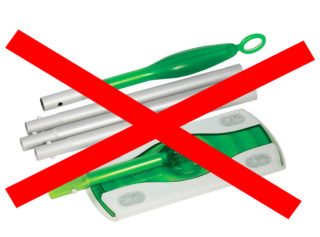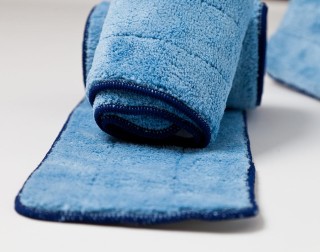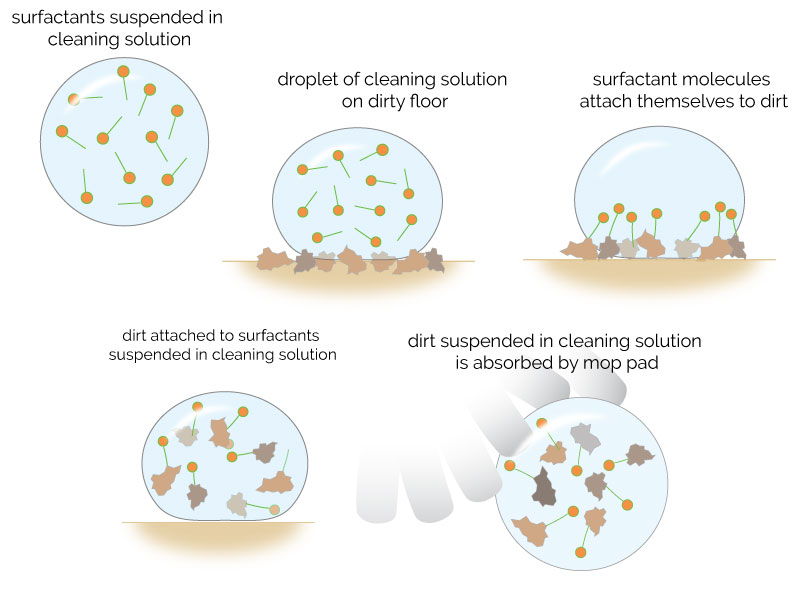4 Must-Have Tools for Cleaning Your Wood Floor
Everyone who loves their wood floor wants a clean wood floor. A floor that will pass the White Sock Test of cleanliness.
To keep your wood floor looking like new, you need to have the right tools. Listed below are the 4 must-have tools to super-clean your wood floors.
 1. A Good Mop Handle
1. A Good Mop Handle
First, you’ll need a sturdy, aluminum microfiber mop handle. Don’t cheap out on the mop handle because you’ll need to use some elbow grease when cleaning a dirty wood floor, especially in the kitchen. Mr. Floor sells and excellent telescoping mop handle here, but there are others you can purchase on Amazon, or at Home Depot, or Ace Hardware that are knock-offs. Here are some mop handle bullet-points to remember.
There must be at least two rows of velcro loop material on the underside of the mop and the Velcro must be riveted to the base of the mop. Don’t buy a mop handle where the Velcro is attached only by adhesive as it will quickly detach from the mop with repeated use.
The mop head must be made of aluminum and must have a reinforced structure with vertical bars that are perpendicular to the base of the mop. A mop that doesn’t have vertical reinforcing bars running the length of the head will quickly bow causing uneven cleaning.
Don’t buy a mop with a plastic head or with a handle that snaps together. (Cough, cough, Swiffer . . . cough!) If you’ve ever owned a mop like this you know it will break within weeks of purchase.
2. Mop Pads That Pick Up Dirt AND Absorb Water
 Second, you’ll need at least three and preferably more machine-washable microfiber mop pads sized to fit your mop. Mr. Floor, of course, sells excellent microfiber mop pads here. There are other good pads on the market, but most are not.
Second, you’ll need at least three and preferably more machine-washable microfiber mop pads sized to fit your mop. Mr. Floor, of course, sells excellent microfiber mop pads here. There are other good pads on the market, but most are not.
When you’re purchasing microfiber mop pads, don’t cheap out. Good mop pads, like ours, don’t bleed their color when machine washed. More importantly the pads are good both at picking up dirt and absorbing water. The reason high-performance mop pads can do both is that they are made from a balanced blend of polyester and polyamide nylon.
Polyester, and inexpensive yarn, provides good scrubbing ability and good electrostatic “pick up” to hold dust. Polyester is oleophilic meaning it can absorb oil, but not water. The inability to absorb water is a problem when you’re trying to mop a wood floor. Microfiber pads made of 100% polyester are great for dry dusting, but they do a poor job at absorbing the dirty cleaning solution when you’re wet mopping a floor.
If the microfiber pad can’t absorb water, the cleaning fluid – with the dirt in solution – stays on the floor. This is one of the reasons after wet mopping a wood floor you’re left with a haze. (Spoiler alert: the other cause of haze is the wrong wood floor cleaner.)
Polyamide nylon, by contrast, is hygroscopic meaning that it can absorb water. Being able to absorb water means that it can attract and retain the cleaning fluid and the dirt that wet-mopping releases.
Find a mop pad that contains both polyester and polyamide fibers.
3. White 16″ x 9″ Bar Towels For Deep Cleaning
Third, when it comes time to deep clean your floor, you’re going to need a dozen white, 16″ x 9″ bar towels to pick up the grease and grime loosened by your first pass with a microfiber mop and pad. While it’s possible to deep clean a wood floor only using microfiber pads, you’ll need to have at least 6 to 10 clean clean pads for the deep cleaning. Our suggestion for the DIY wood floor deep cleaning is to use inexpensive white bar towels folded in half and attached to the loop fasteners of the mop head for the second, third and subsequent cleaning passes of your floor. Remember, after the floor passes the “white sock test”, you need to go over it one more time with a clean microfiber pad to buff in the perfect shine.
4. A Wood Floor Cleaner With The Right Surfactants
OK, I’m going to try and convince you to try Mr. Floor Wood Floor Cleaner in this section. Yes, we want to sell you cleaner. And yes, we believe that it’s far and away the best every-day and deep-cleaning wood floor cleaner available.
Before I make the pitch, let’s talk surfactants.
Surfactants, the industry term for Surface-Active-Agents, are molecules that repel water (hydrophobic) and have an electric charge that can attract dirt.
Because of these two properties, surfactant molecules will seek out anything in a solution that is not water, including dirt, grease, etc. Most spray on cleaners are a blend of water and surfactants, (with a few other chemicals to make the cleaner pretty and smell good.) When you spray a high-quality wood floor cleaner on to your floor, you are applying surfactants in a solution of water. This surfactant solution, along with the mechanical action of the mop, loosens the grease and dirt from the floor.
As the diagram suggests, the surfactant molecules circle around anything that’s not water, like ants surrounding a cube of sugar. With the dirt surrounded by the surfactant molecules, effectively suspending them in the water solution, the mop can them pick up the dirt – if the mop head has water-absorbent polyamide fibers. (See! I told you polyamide nylon in a mop pad was important.)
How effectively your cleaner releases dirt from the floor and holds it suspended in the solution depends on the type and quality of surfactants.
There are three common types of surfactants used in modern cleaners.
The first type of surfactant, Anionic, is a negatively charged. Anionic surfactants are relatively inexpensive and fairly effective at lifting dirt. Anionic surfactants are generally characterized by their foaming property. While Anionic surfactants are effective dirt lifters, they tend to be alkaline in nature which is bad for wood floor finishes. An alkaline cleaner can harm the polymer finish on your floor creating a permanent cloudy haze. Anionic surfactants are also known to cause skin dermatitis, which makes them potentially dangerous if not handled with care. A lot of brand-name floor cleaners and all-purpose cleaners use some quantity of Anionic surfactants.
Cationic surfactants carry a positive charge and are often found in laundry detergents and fabric softeners where the Cationic surfactant’s positive charge helps to reduce static. Cationic surfactants are not, however, very good at removing grease or suspending dirt, making them less useful in a wood floor cleaner. Only a few all-purpose cleaners that claim to be good for wood floors use cationic surfactants.
Non-ionic surfactants are a bit more expensive than the alternatives, but they’re pH neutral, excellent at releasing dirt, safe for you and your family, and do a good job of keeping that dirt in suspension in water. That’s a really critical point. If the grease and dirt released from the floor are not kept in suspension until the mop can soak up the solution or grab the particles, the dirt is just redistributed back to the floor.
At Mr. Floor, we believe that the right blend of non-ionic surfactants is the key to a superior wood floor cleaner.
So here’s the pitch. Mr. Floor has installed and refinished over 20,000 wood floors in homes, businesses and institutions. We know what it takes to keep your wood floor White Sock Test clean and looking like new.
We created the Mr. Floor Wood Floor Cleaner to keep our clients happy with their floor. In fact, we always give a bottle of our cleaner away with any wood floor work we do because we know it’s crucial to protecting their floor.
Try our wood floor cleaner today and you can SAVE 20%. Your satisfaction is guaranteed. If for any reason you aren’t satisfied, we’ll refund your money.
To take advantage of this special offer, use the coupon code “TryMrFloor”. This offer is valid for new customers only, so act today!

